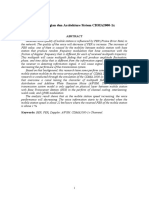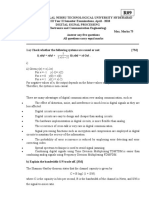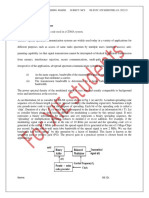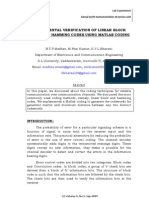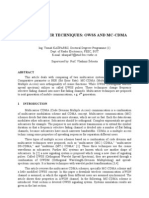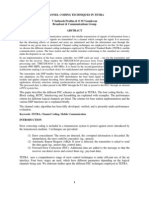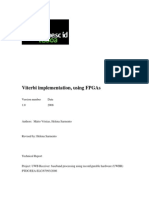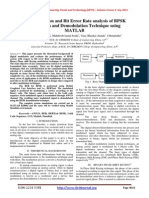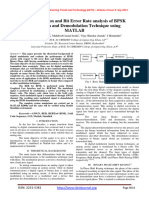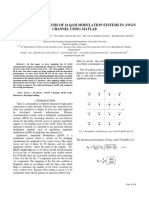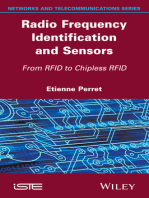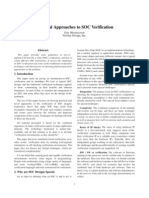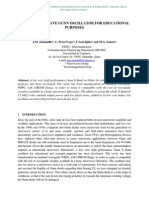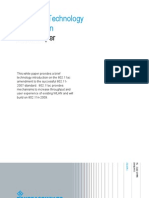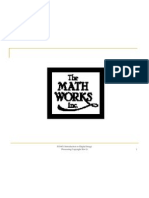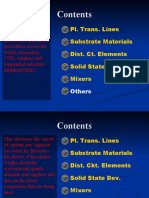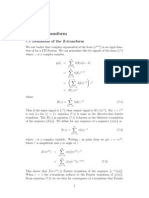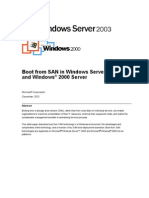Channel Coding: Version 2 ECE IIT, Kharagpur
Uploaded by
HarshaChannel Coding: Version 2 ECE IIT, Kharagpur
Uploaded by
HarshaModule
Channel Coding
Version 2 ECE IIT, Kharagpur
Lesson
36
Coded Modulation
Schemes
Version 2 ECE IIT, Kharagpur
After reading this lesson, you will learn about
¾ Trellis Code Modulation;
¾ Set partitioning in TCM;
¾ Decoding TCM;
The modulated waveform in a conventional uncoded carrier modulation scheme
contains all information about the modulating message signal. As we have discussed
earlier in Module #5, the modulating signal uses the quadrature carrier sinusoids in PSK
and QAM modulations. The modulator accepts the message signal in discrete time
discrete amplitude from (binary or multilevel) and processes it following the chosen
modulation scheme to satisfy the transmission and reception requirements. The
modulating signal is generally treated as a random signal and the modulating symbols are
viewed as statistically independent and having equal probability of occurrence. This
traditional approach has several merits such as, (i) simplified system design and analysis
because of modular approach, (ii) design of modulation and transmission schemes which
are independent of the behavior of signal source, (iii) availability of well developed
theory and practice for the design of receivers which are optimum (or near optimum).
To put it simply, the modular approach to system design allows one to design a
modulation scheme almost independent of the preceding error control encoder and the
design of an encoder largely independent of the modulation format. Hence, the end-to-
end system performance is made up of the gains contributed by the encoder, modulator
and other modules separately.
However, it is interesting to note that the demarcation between a coder and a
modulator is indeed artificial and one may very well imagine a combined coded
modulation scheme. The traditional approach is biased more towards optimization of an
encoder independent of the modulation format and on optimization of a modulation
scheme independent of the coding strategy. In fact, such approach of optimization at the
subsystem level may not ensure an end-to-end optimized system design.
A systems approach towards a combined coding and modulation scheme is
meaningful in order to obtain better system performance. Significant progress has taken
place over the last two decades on the concepts of combined coding and modulation (also
referred as coded modulation schemes). Several schemes have been suggested in the
literature and advanced modems have been successfully developed exploiting the new
concepts. Amongst the several strategies, which have been popular, trellis coded
modulation (TCM) is a prominent one. A trellis coded modulation scheme improves the
reliability of a digital transmission system without bandwidth expansion or reduction of
data rate when compared to an uncoded transmission scheme using the same transmission
bandwidth.
We discuss the basic features of TCM in this section after introducing some
concepts of distance measure etc., common to all coded modulation schemes. A TCM
scheme uses the concept of tree or trellis coding and hence is the name ‘TCM’. However
Version 2 ECE IIT, Kharagpur
some interesting combined coding and modulation schemes have been suggested recently
following the concepts of block coding as well.
Distance Measure
Let us consider a 2-dimensional signal space of Fig.6.36.1 showing a set of signal
points. The two dimensions are defined by two orthonormal basis functions
corresponding to information symbols, which are to be modulated. The dimensions and
hence the x- and y-axes may also be interpreted as ‘real’ and ‘imaginary’ axes when
complex low pass equivalent representation of narrowband modulated signals is
considered. The points in the constellation are distinguishable from one another as their
locations are separate. Several possible subsets have been indicated in Fig.6.36.1
capturing multiple modulation formats.
Subset 1
Subset 2
Subset 3
Subset 4
Fig.6.36.1 Some two-dimensional signal constellations (M = 2m, m= 1,…,8) of TCM
codes.
Version 2 ECE IIT, Kharagpur
Let there be ‘N’ valid signal points, denoted by (xi + jyi) , 1≤ i ≤ N, in the two
dimensional signal space such that each point signifies an information bearing symbol (or
signal) different from one another. Now, the Euclidean distance dij between any two
signal points, say (xi, yi) and (xj, yj) in this 2 –D Cartesian signal space may be expressed
as, d2ij =(xi-xj)2 +(yi-yj)2. Note that for detecting a received symbol at the demodulator in
presence of noise etc., it is important to maximize the minimum distance (say, dmin)
between any two adjacent signal points in the space. This implies that the N signal points
should be well distributed in the signal space such that the dmin amongst them is the
largest. This strategy ensures good performance of a demodulation scheme especially
when all the symbols are equally likely to occur.
Suppose we wish to transmit data from a source emitting two information bits
every T seconds. One can design a system in several ways to accomplish the task such as
the following:
(i) use uncoded QPSK modulation, with one signal carrying two information bits
transmitted every T seconds.
(ii) use a convolutional code of rate r = 2/3 and same QPSK modulation. Each QPSK
symbol now carries 4/3 information bits and hence, the symbol duration should be
reduced to 2T/3 seconds. This implies that the required transmission bandwidth is 50%
more compared to the scheme in (i).
(i) use a convolutional code of rate r = 2/3 and 8-Phase Shift Keying (8PSK) modulation
scheme to ensure a symbol duration of T sec. Each symbol, now consisting of 3 bits,
carries two bits of information and no expansion in transmission bandwidth is necessary.
This is the basic concept of TCM.
Now, an M-ary PSK modulation scheme is known to be more and more power
inefficient for larger values of M. That is, to ensure an average BER of, say, 10-5, 8-PSK-
modulation scheme needs more Eb/No compared to QPSK and 16-PSK scheme needs
even more of Eb/No. So, one may apprehend that the scheme in (iii) may be power
inefficient but actually this is not true as the associated convolutional code ensures a
considerable improvement in the symbol detection process. It has been found that an
impressive overall coding gain to the tune of 3 – 6dB may be achieved at an average BER
of 10-5. So, the net result of this approach of combined coding and modulation is some
coding gain at no extra bandwidth. The complexity of such a scheme is comparable to
that of a scheme employing coding (with soft decision decoding) and demodulation
schemes separately.
TCM is extensively used in high bit rate modems using telephone cables. The additional
coding gain due to trellis-coded modulation has made it possible to increase the speed of
the transmission.
Version 2 ECE IIT, Kharagpur
Set Partitioning
The central feature of TCM is based on the concept of signal-set partitioning that
creates scope of redundancy for coding in the signal space. The minimum Euclidean
distance (dmin) of a TCM scheme is maximized through set partitioning.
The concept of set partitioning is shown in Fig. 6.36.2 for a 16-QAM signal
constellation. The constellation consists of 16 signal points where each point is
represented by four information bits. The signal set is successively divided into smaller
sets with higher values of minimum intra-set distance. The smallest signal constellations
finally obtained are labeled as D0, D1, … , D7 in Fig. 6.36.2. The following basic rules
are followed for set-partitioning:
Rule #1: Members of the same partition are assigned to parallel transitions.
Rule #2: Members of the next larger partition are assigned to adjacent transitions, i.e.
transitions stemming from, or merging in the same node.
Assumption: All the signal points are equally likely to occur.
1
Z0 = 0
A
Z1 = 0
B0 1 Z1 = 0 B1 1
C0 C2 C3
C1 1 1
Z2 = 0 1 Z2 = 0 Z2 = 0 Z2 = 0 1
D0 D1 D2 D3 D4 D5 D6 D7
Fig. 6.36.2 Set partitioning of the 16QAM constellation
A TCM encoder consists of a convolutional encoder cascaded to a signal mapper.
Fig. 6.36.3 shows the general structure of a TCM encoder. As shown in the figure, a
group of m-bits are considered at a time. The rate n/(n+1) convolutional encoder codes n
information bits into a codeword of (n+1) bits while the remaining (m-n) bits are not
encoded. However, the new group of (n+1+m-n) = m+1 bits are used to select one of the
2m+1 points from the signal space following the technique of set-partitioning.
Version 2 ECE IIT, Kharagpur
m−n m−n m +1 Z im +1
bm Signal
i
Mapping
m −1
Z im
bi Uncoded
Bits
Select Signal Xni
Z in + 2 From Subsets
bin +1
n n +1 Z in +1
Convolutional Coded
bin Bits
Encoder
n
Rate = Z i1 Select
1
b n +1 Subsets
i
Fig. 6.36.3 General structure of TCM encoder
The convolutional encoder may be one of several possible types such a linear
non-systematic feed forward type or a feedback type etc. Fig. 6.36.4 shows an encoder of
r = 2/3, suitable for use with a 8-point signal constellation.
xn2 Z n2
xn: h =1
2
2
Z n1
T Z n0
T + T + h =1
0
h30 = 1 0
Fig. 6.36.4 Structure of a TCM encoder based on r=2/3 convolutional coding and 8-PSK
modulation format
Decoding TCM
The concept of code trellis, as introduced in Lesson #35, is expanded to describe
the operation of a TCM decoder. Distance properties of a TCM scheme can be studied
through its trellis diagram in the same way as for convolutional codes. The TCM
decoder-demodulator searches the most likely path through the trellis from the received
Version 2 ECE IIT, Kharagpur
sequence of noisy signal points. Because of noise, the chosen path may not always
coincide with the correct path. The Viterbi algorithm is also used in the TCM decoder.
Note that there is a one-to-one correspondence between signal sequences and the paths in
a trellis. Hence, the maximum-likelihood (ML) decision on a sequence of received
symbols consists of searching for the trellis path with the minimum Euclidean distance to
the received sequence. The resultant trellis for TCM looks somewhat different compared
to the trellis of a convolutional code only. There will be multiple parallel branches
between two nodes all of which will correspond to the same bit pattern for the first (n+1)
bits as obtained from the convolutional encoder.
Version 2 ECE IIT, Kharagpur
You might also like
- A Low Power VITERBI Decoder Design With Minimum Transition Hybrid Register Exchange Processing For Wireless ApplicationsNo ratings yetA Low Power VITERBI Decoder Design With Minimum Transition Hybrid Register Exchange Processing For Wireless Applications9 pages
- Electrical - IJEEE - A Non-Binary Turbo Trellis - Raad H. ThaherNo ratings yetElectrical - IJEEE - A Non-Binary Turbo Trellis - Raad H. Thaher12 pages
- Trellis Coded Modulation (TCM) : Intuitive Guide To Principles of CommunicationsNo ratings yetTrellis Coded Modulation (TCM) : Intuitive Guide To Principles of Communications0 pages
- Bagian-Bagian Dan Arsitekture Sistem CDMA2000-1xNo ratings yetBagian-Bagian Dan Arsitekture Sistem CDMA2000-1x16 pages
- Software-Defined Radio Lab 2: Data Modulation and TransmissionNo ratings yetSoftware-Defined Radio Lab 2: Data Modulation and Transmission8 pages
- Analysis of BER For MIMO-STBC With Different Modulation TechniquesNo ratings yetAnalysis of BER For MIMO-STBC With Different Modulation Techniques4 pages
- Soft-Output Sphere Decoding Performance and Implementation Aspects PDFNo ratings yetSoft-Output Sphere Decoding Performance and Implementation Aspects PDF6 pages
- Low-Power Design of Reed-Solomon Encoders: Wei Zhang, Jing Wang Xinmiao ZhangNo ratings yetLow-Power Design of Reed-Solomon Encoders: Wei Zhang, Jing Wang Xinmiao Zhang4 pages
- BER Analysis of STBC Codes For MIMO Rayleigh Flat Fading ChannelsNo ratings yetBER Analysis of STBC Codes For MIMO Rayleigh Flat Fading Channels5 pages
- Experimental Verification of Linear Block Codes and Hamming Codes Using Matlab CodingNo ratings yetExperimental Verification of Linear Block Codes and Hamming Codes Using Matlab Coding17 pages
- Design of Spreading Permutations For MIMO-CDMA Based On Space-Time Block CodesNo ratings yetDesign of Spreading Permutations For MIMO-CDMA Based On Space-Time Block Codes3 pages
- EC 2301 Digital Communication Unit I and II Question BankNo ratings yetEC 2301 Digital Communication Unit I and II Question Bank63 pages
- Kiran Gunnam, Weihuang Wang, Euncheol Kim, Gwan Choi, Mark YearyNo ratings yetKiran Gunnam, Weihuang Wang, Euncheol Kim, Gwan Choi, Mark Yeary6 pages
- Implementation and Bit Error Rate Analysis of BPSK Modulation and Demodulation Technique Using MATLAB100% (1)Implementation and Bit Error Rate Analysis of BPSK Modulation and Demodulation Technique Using MATLAB5 pages
- Bartis Mocanu Enescu Anghel Timisoara PDFExpressNo ratings yetBartis Mocanu Enescu Anghel Timisoara PDFExpress4 pages
- Notes on Fading Properties of SPread spectrumNo ratings yetNotes on Fading Properties of SPread spectrum47 pages
- Tornado Codes and Luby Transform Codes PDFNo ratings yetTornado Codes and Luby Transform Codes PDF12 pages
- Ber Performance of STBC Encoded Mimo Systems: Kanaka Durga Devi P M, K.YOGA PRASADNo ratings yetBer Performance of STBC Encoded Mimo Systems: Kanaka Durga Devi P M, K.YOGA PRASAD3 pages
- FPGA Implementation of Soft Output Viterbi Algorithm Using Memoryless Hybrid Register Exchange MethodNo ratings yetFPGA Implementation of Soft Output Viterbi Algorithm Using Memoryless Hybrid Register Exchange Method9 pages
- Performance Improvement of Mc-Cdma System Through DSTBC Site DiversityNo ratings yetPerformance Improvement of Mc-Cdma System Through DSTBC Site Diversity8 pages
- Simulation of A CDMA Systems Using Linear Prediction and MUD (Matlab)100% (2)Simulation of A CDMA Systems Using Linear Prediction and MUD (Matlab)44 pages
- I Nternational Journal of Computational Engineering Research (Ijceronline - Com) Vol. 2 Issue. 7No ratings yetI Nternational Journal of Computational Engineering Research (Ijceronline - Com) Vol. 2 Issue. 76 pages
- Compression: Author: Paul Penfield, Jr. 2004 Massachusetts Institute of Technology Url: Start: Back: NextNo ratings yetCompression: Author: Paul Penfield, Jr. 2004 Massachusetts Institute of Technology Url: Start: Back: Next8 pages
- Digital Communication Systems by Simon Haykin-117No ratings yetDigital Communication Systems by Simon Haykin-1176 pages
- Carrier Modulation: Version 2 ECE IIT, KharagpurNo ratings yetCarrier Modulation: Version 2 ECE IIT, Kharagpur6 pages
- Comparative Study of Turbo Codes in AWGN Channel Using MAP and SOVA DecodingNo ratings yetComparative Study of Turbo Codes in AWGN Channel Using MAP and SOVA Decoding14 pages
- BER Performance of Uplink Massive MIMO With Low-Resolution ADCsNo ratings yetBER Performance of Uplink Massive MIMO With Low-Resolution ADCs5 pages
- Numerically Controlled Oscillator With Spur Reduction: Hans-Jörg Pfleiderer Stefan LachowiczNo ratings yetNumerically Controlled Oscillator With Spur Reduction: Hans-Jörg Pfleiderer Stefan Lachowicz4 pages
- Performance Analysis of 16 Qam Modulation Systems in Awgn Channel Using MatlabNo ratings yetPerformance Analysis of 16 Qam Modulation Systems in Awgn Channel Using Matlab6 pages
- Radio Frequency Identification and Sensors: From RFID to Chipless RFIDFrom EverandRadio Frequency Identification and Sensors: From RFID to Chipless RFIDNo ratings yet
- Analytical Modeling of Wireless Communication SystemsFrom EverandAnalytical Modeling of Wireless Communication SystemsNo ratings yet
- Advanced Multicarrier Technologies for Future Radio Communication: 5G and BeyondFrom EverandAdvanced Multicarrier Technologies for Future Radio Communication: 5G and BeyondNo ratings yet
- Some Case Studies on Signal, Audio and Image Processing Using MatlabFrom EverandSome Case Studies on Signal, Audio and Image Processing Using MatlabNo ratings yet
- Enabling Technologies for High Spectral-efficiency Coherent Optical Communication NetworksFrom EverandEnabling Technologies for High Spectral-efficiency Coherent Optical Communication NetworksNo ratings yet
- IEEE 802.11 Wireless LAN: Draft StandardNo ratings yetIEEE 802.11 Wireless LAN: Draft Standard23 pages
- Image Segmentation Algorithms: - Otsu (1979) - Fisher (1936)No ratings yetImage Segmentation Algorithms: - Otsu (1979) - Fisher (1936)13 pages
- 529 - Microwave Circuit Design by PrashanthNo ratings yet529 - Microwave Circuit Design by Prashanth38 pages
- Data Sheet - How To Use PsPing To Test Ping, Latency & Bandwidth Between Blue Prism ComponentsNo ratings yetData Sheet - How To Use PsPing To Test Ping, Latency & Bandwidth Between Blue Prism Components8 pages
- Logical Link Control and Adaptation ProtocolNo ratings yetLogical Link Control and Adaptation Protocol7 pages
- Design and Analysis of Algorithms 214.: Introduction To The C Programming LanguageNo ratings yetDesign and Analysis of Algorithms 214.: Introduction To The C Programming Language14 pages
- Yottabytes and Beyond: Demystifying Storage and Building Large Storage Networks by Bhavin Turakhia, CEO, DirectiNo ratings yetYottabytes and Beyond: Demystifying Storage and Building Large Storage Networks by Bhavin Turakhia, CEO, Directi47 pages
- ABAP HANA Via Secondary Database ConnectionNo ratings yetABAP HANA Via Secondary Database Connection34 pages
- Create Multiple Purchase Orders in SAPNo ratings yetCreate Multiple Purchase Orders in SAP11 pages
- Relationship Between Pointers and ArraysNo ratings yetRelationship Between Pointers and Arrays46 pages
- The Usbmon: USB Monitoring Framework: Pete Zaitcev Red Hat, IncNo ratings yetThe Usbmon: USB Monitoring Framework: Pete Zaitcev Red Hat, Inc6 pages
- XML Web Services For The Microsoft .NET PlatformNo ratings yetXML Web Services For The Microsoft .NET Platform388 pages
- +2348183751137 Join Python Kings Brotherhood Occult Fraternity For Instant Money Ritual Don't Die in Silence. I Want To Join Occult? Call The Grand Master 08183751137No ratings yet+2348183751137 Join Python Kings Brotherhood Occult Fraternity For Instant Money Ritual Don't Die in Silence. I Want To Join Occult? Call The Grand Master 0818375113712 pages
- A Low Power VITERBI Decoder Design With Minimum Transition Hybrid Register Exchange Processing For Wireless ApplicationsA Low Power VITERBI Decoder Design With Minimum Transition Hybrid Register Exchange Processing For Wireless Applications
- Electrical - IJEEE - A Non-Binary Turbo Trellis - Raad H. ThaherElectrical - IJEEE - A Non-Binary Turbo Trellis - Raad H. Thaher
- Trellis Coded Modulation (TCM) : Intuitive Guide To Principles of CommunicationsTrellis Coded Modulation (TCM) : Intuitive Guide To Principles of Communications
- Software-Defined Radio Lab 2: Data Modulation and TransmissionSoftware-Defined Radio Lab 2: Data Modulation and Transmission
- Analysis of BER For MIMO-STBC With Different Modulation TechniquesAnalysis of BER For MIMO-STBC With Different Modulation Techniques
- Soft-Output Sphere Decoding Performance and Implementation Aspects PDFSoft-Output Sphere Decoding Performance and Implementation Aspects PDF
- Low-Power Design of Reed-Solomon Encoders: Wei Zhang, Jing Wang Xinmiao ZhangLow-Power Design of Reed-Solomon Encoders: Wei Zhang, Jing Wang Xinmiao Zhang
- BER Analysis of STBC Codes For MIMO Rayleigh Flat Fading ChannelsBER Analysis of STBC Codes For MIMO Rayleigh Flat Fading Channels
- Experimental Verification of Linear Block Codes and Hamming Codes Using Matlab CodingExperimental Verification of Linear Block Codes and Hamming Codes Using Matlab Coding
- Design of Spreading Permutations For MIMO-CDMA Based On Space-Time Block CodesDesign of Spreading Permutations For MIMO-CDMA Based On Space-Time Block Codes
- EC 2301 Digital Communication Unit I and II Question BankEC 2301 Digital Communication Unit I and II Question Bank
- Kiran Gunnam, Weihuang Wang, Euncheol Kim, Gwan Choi, Mark YearyKiran Gunnam, Weihuang Wang, Euncheol Kim, Gwan Choi, Mark Yeary
- Implementation and Bit Error Rate Analysis of BPSK Modulation and Demodulation Technique Using MATLABImplementation and Bit Error Rate Analysis of BPSK Modulation and Demodulation Technique Using MATLAB
- Ber Performance of STBC Encoded Mimo Systems: Kanaka Durga Devi P M, K.YOGA PRASADBer Performance of STBC Encoded Mimo Systems: Kanaka Durga Devi P M, K.YOGA PRASAD
- FPGA Implementation of Soft Output Viterbi Algorithm Using Memoryless Hybrid Register Exchange MethodFPGA Implementation of Soft Output Viterbi Algorithm Using Memoryless Hybrid Register Exchange Method
- Performance Improvement of Mc-Cdma System Through DSTBC Site DiversityPerformance Improvement of Mc-Cdma System Through DSTBC Site Diversity
- Simulation of A CDMA Systems Using Linear Prediction and MUD (Matlab)Simulation of A CDMA Systems Using Linear Prediction and MUD (Matlab)
- I Nternational Journal of Computational Engineering Research (Ijceronline - Com) Vol. 2 Issue. 7I Nternational Journal of Computational Engineering Research (Ijceronline - Com) Vol. 2 Issue. 7
- Compression: Author: Paul Penfield, Jr. 2004 Massachusetts Institute of Technology Url: Start: Back: NextCompression: Author: Paul Penfield, Jr. 2004 Massachusetts Institute of Technology Url: Start: Back: Next
- Comparative Study of Turbo Codes in AWGN Channel Using MAP and SOVA DecodingComparative Study of Turbo Codes in AWGN Channel Using MAP and SOVA Decoding
- BER Performance of Uplink Massive MIMO With Low-Resolution ADCsBER Performance of Uplink Massive MIMO With Low-Resolution ADCs
- Numerically Controlled Oscillator With Spur Reduction: Hans-Jörg Pfleiderer Stefan LachowiczNumerically Controlled Oscillator With Spur Reduction: Hans-Jörg Pfleiderer Stefan Lachowicz
- Performance Analysis of 16 Qam Modulation Systems in Awgn Channel Using MatlabPerformance Analysis of 16 Qam Modulation Systems in Awgn Channel Using Matlab
- Radio Frequency Identification and Sensors: From RFID to Chipless RFIDFrom EverandRadio Frequency Identification and Sensors: From RFID to Chipless RFID
- Analytical Modeling of Wireless Communication SystemsFrom EverandAnalytical Modeling of Wireless Communication Systems
- Error-Correction on Non-Standard Communication ChannelsFrom EverandError-Correction on Non-Standard Communication Channels
- Advanced Multicarrier Technologies for Future Radio Communication: 5G and BeyondFrom EverandAdvanced Multicarrier Technologies for Future Radio Communication: 5G and Beyond
- Some Case Studies on Signal, Audio and Image Processing Using MatlabFrom EverandSome Case Studies on Signal, Audio and Image Processing Using Matlab
- Enabling Technologies for High Spectral-efficiency Coherent Optical Communication NetworksFrom EverandEnabling Technologies for High Spectral-efficiency Coherent Optical Communication Networks
- Image Segmentation Algorithms: - Otsu (1979) - Fisher (1936)Image Segmentation Algorithms: - Otsu (1979) - Fisher (1936)
- Data Sheet - How To Use PsPing To Test Ping, Latency & Bandwidth Between Blue Prism ComponentsData Sheet - How To Use PsPing To Test Ping, Latency & Bandwidth Between Blue Prism Components
- Design and Analysis of Algorithms 214.: Introduction To The C Programming LanguageDesign and Analysis of Algorithms 214.: Introduction To The C Programming Language
- Yottabytes and Beyond: Demystifying Storage and Building Large Storage Networks by Bhavin Turakhia, CEO, DirectiYottabytes and Beyond: Demystifying Storage and Building Large Storage Networks by Bhavin Turakhia, CEO, Directi
- The Usbmon: USB Monitoring Framework: Pete Zaitcev Red Hat, IncThe Usbmon: USB Monitoring Framework: Pete Zaitcev Red Hat, Inc
- +2348183751137 Join Python Kings Brotherhood Occult Fraternity For Instant Money Ritual Don't Die in Silence. I Want To Join Occult? Call The Grand Master 08183751137+2348183751137 Join Python Kings Brotherhood Occult Fraternity For Instant Money Ritual Don't Die in Silence. I Want To Join Occult? Call The Grand Master 08183751137



